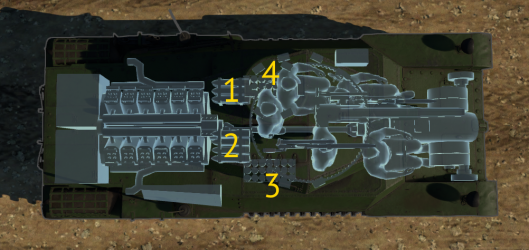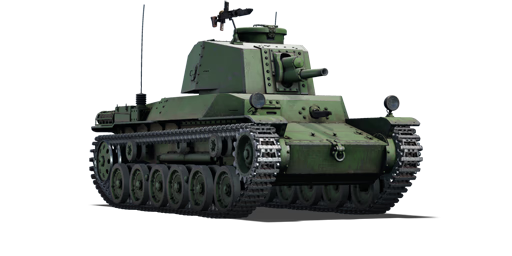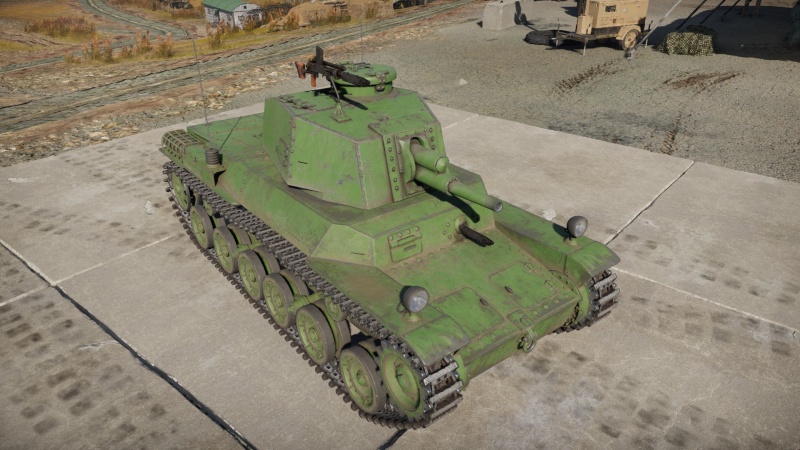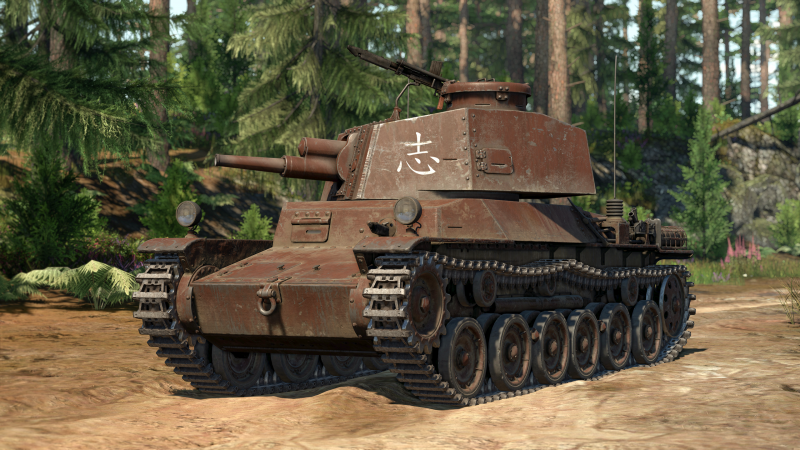Ho-I
Contents
Description
The Type 2 Ho-I is a rank I Japanese medium tank with a battle rating of 2.3 (AB) and 2.0 (RB/SB). It was introduced with the rest of the Japanese ground forces tree with Update 1.65 "Way of the Samurai".
The general configuration and proportions of the Ho-I are largely similar to the Chi-Ha Kai. The most apparent differences are the angular, welded hull and turret, which will become a familiar sight for the rest of the Japanese medium tanks in Rank II and III. The protection is improved significantly, no longer having the paper-thin armour plaguing previous tanks, but it is still nothing to boast about. Closer inspection reveals a larger, stubby 75 mm gun that is trickier to use than the reliable 47 mm gun on the Chi-Ha Kai but is fully capable of penetrating most tanks it will face. Overall, the Ho-I is comparable to the Pz.IV E, a balanced medium tank with a short 75 mm gun.
General info
Survivability and armour
The armour on the Ho-I, while being an upgrade over the Chi-Ha - 50 mm at the turret and hull front, compared to 25-, still leaves much to be desired. Most contemporary tank guns can penetrate the flatter surfaces and the side armour is not even completely proof to heavy machine guns. The internal modules aren't the most resilient, as the turret is rather cramped, stuffed with ammunition, the rather small cannon breech, and 3 crew members. A single APHE shell will almost invariably kill all the turret crew.
The armour consists of rolled mostly homogeneous armour, with cast homogeneous surrounding the gun barrel, protruding from the turret.
Armour type:
- Rolled homogeneous armour (hull, turret, cupola)
- Cast homogeneous armour (gun mantlet)
| Armour | Front (Slope angle) | Sides | Rear | Roof |
|---|---|---|---|---|
| Hull | 50 mm (16°) Front Plate 12 mm (76°) Front Glacis |
25 mm (30°) Hull below tracks 20 mm Hull above tracks |
20 mm | 12 mm (4°) Roof |
| Turret | 50 mm (16°) Turret Front 50 mm (16°) Gun Mantlet |
25 mm (9-10°) | 25 mm (5°) | 12 mm (76°) Front 12 mm (89°) Middle 12 mm (74°) Rear |
| Cupola | 50 mm Lower Part 25 mm Upper Part |
12 mm | ||
Mobility
| Game Mode | Max Speed (km/h) | Weight (tons) | Engine power (horsepower) | Power-to-weight ratio (hp/ton) | |||
|---|---|---|---|---|---|---|---|
| Forward | Reverse | Stock | Upgraded | Stock | Upgraded | ||
| Arcade | 49 | 10 | 16.1 | 372 | 458 | 23.11 | 28.45 |
| Realistic | 44 | 9 | 212 | 240 | 13.17 | 14.91 | |
The mobility of the Ho-I is improved over the Chi-Ha, the more powerful engine giving it a higher power-to-weight ratio. The relatively long tracks for a vehicle of this weight and width lead to fairly good cross-country mobility. While not a speedster, the Ho-I will not be completely left in the dust by light tanks and can still arrive at the battlefield reasonably quickly.
Modifications and economy
Armaments
Main armament
| 75 mm Type 99 | Turret rotation speed (°/s) | Reloading rate (seconds) | |||||||||||
|---|---|---|---|---|---|---|---|---|---|---|---|---|---|
| Mode | Capacity | Vertical | Horizontal | Stabilizer | Stock | Upgraded | Full | Expert | Aced | Stock | Full | Expert | Aced |
| Arcade | 63 | -15°/+20° | ±180° | N/A | 13.33 | 18.45 | 22.40 | 24.77 | 26.35 | 7.67 | 6.79 | 6.25 | 5.90 |
| Realistic | 8.33 | 9.80 | 11.90 | 13.16 | 14.00 | ||||||||
Ammunition
| Penetration statistics | ||||||
|---|---|---|---|---|---|---|
| Ammunition | Penetration @ 0° Angle of Attack (mm) | |||||
| 10 m | 100 m | 500 m | 1,000 m | 1,500 m | 2,000 m | |
| Type 95 APHE | 43 | 41 | 37 | 31 | 27 | 23 |
| Type 94 HE | 12 | 12 | 12 | 12 | 12 | 12 |
| Type 2 HEAT | 90 | 90 | 90 | 90 | 90 | 90 |
| Shell details | ||||||||
|---|---|---|---|---|---|---|---|---|
| Ammunition | Velocity (m/s) |
Projectile Mass (kg) |
Fuse delay (m) |
Fuse sensitivity (mm) |
Explosive Mass (TNT equivalent) (g) |
Ricochet | ||
| 0% | 50% | 100% | ||||||
| Type 95 APHE | 450 | 6.21 | 1.2 | 14 | 460 | 47° | 60° | 65° |
| Type 94 HE | 522 | 6.02 | 0 | 0.1 | 810 | 79° | 80° | 81° |
| Type 2 HEAT | 350 | 3.56 | 0.05 | 0.1 | 640 | 62° | 69° | 73° |
| Smoke shell characteristics | ||||||
|---|---|---|---|---|---|---|
| Ammunition | Velocity (m/s) |
Projectile Mass (kg) |
Screen radius (m) |
Screen deploy time (s) |
Screen hold time (s) |
Explosive Mass (TNT equivalent) (g) |
| Type 90 Smoke | 570 | 5.72 | 13 | 5 | 20 | 100 |
Ammo racks

| Full ammo |
1st rack empty |
2nd rack empty |
3rd rack empty |
4th rack empty |
Visual discrepancy |
|---|---|---|---|---|---|
| 63 | 55 (+ 8) | 43 (+ 20) | 22 (+ 41) | 1 (+ 62) | No |
Notes:
- Racks disappear after you've fired all shells in the rack.
- Turret empty: 43 (+ 20) shells.
Machine guns
While it has the classic bow-mounted Type 97 machine gun featured by Japanese wartime tanks, the Ho-I also features another Type 97 on a pintle mount. The Type 97 is disappointing by rifle-calibre machine gun standards, having a very small magazine and a relatively low rate of fire. While this is not a big drawback when fighting other tanks, it makes mowing down open-topped SPAAs, fending off aircraft, and spotting enemies on the minimap more difficult. Having two of them compensates slightly for these flaws.
| 7.7 mm Type 97 | ||||
|---|---|---|---|---|
| Mount | Capacity (Belt) | Fire rate | Vertical | Horizontal |
| Pintle | 1,000 (20) | 498 | -10°/+70° | ±60° |
| Hull | 3,000 (20) | 498 | ±8° | ±14° |
Usage in battles
The Ho-I should generally be played as a support tank. While its mobility is good, its gun packs a punch, and its armour is halfway decent, the poor ballistics of its shells and the substandard gun handling are a considerable liability at its rank, where speedy light tanks are common. A missed shot at closer distances against a Stuart or BT tank could have unfortunate consequences, allowing them to flank or put a round into the Ho-I's weak spots. Conversely, it should go without saying that the Ho-I makes for a poor sniper, so staying in back of the map and providing covering fire is unlikely to be productive. For those not very familiar with the tank, it is best to stay just behind advancing teammates and allow them to attract attention; this provides extra time to line up shots and avoids sudden surprises. When missing shots is less of a concern (e.g. against slow targets or in close quarters), the great firepower can be brought to bear.
The Ho-I has a sizeable arsenal of shell types. The stock Type 95 APHE round is quite underwhelming, having a bit less penetration than the Ke-Ni reserve tank's gun. The larger calibre provides some overmatch effect, but in general it is not a reliable weapon against anything more heavily armoured than a reserve tank. The M3A1 Stuart's turret is immune to the round and the hull has a decent chance of shrugging off the shot at a slight distance! On the bright side, it contains an enormous 460 g of TNT filler, so any target that the shell manages to penetrate will be annihilated in short order. The Type 94 HE round has 12 mm of penetration and is of little value, though it may be useful for destroying lightly armoured vehicles with overpressure effect. The unlockable Type 2 HEAT round has 90 mm of penetration at any distance. This is enough to go through the frontal armour of nearly all tanks at its rank, though the post-penetration damage can be punctual and it has the worst ballistics of any shell type available to the Ho-I. Try to aim for critical crew members or ammo racks. Lastly, the Type 90 smoke shell is available. While smoke is always nice to have, especially at lower ranks where fewer tanks have smoke grenades or shells, it is especially useful for tanks with low-velocity guns like the Ho-I. In a support role, smoke shells can be used to hide teammates and the user from view when driving in the open or capturing objectives, but they can also be used offensively by blinding entrenched targets. This makes it easier for the Ho-I to advance safely and get into firing range. If the enemies decide to leave the smoke cloud, they will be noticeable to the Ho-I slightly before their own vision clears up, providing time for a careful shot.
Experience gained with the Ho-I can be applied to some extent to the later Chi-He, Chi-Nu, and Chi-Nu II, as they all use the same chassis. Out of these tanks, the Ho-I is the only model that has to deal with a low-velocity gun, but it currently has the lowest battle rating and the armour holds up the best as a result.
Pros and cons
Pros:
- 75 mm cannon can do respectable damage against other vehicles
- Improved armour and mobility in comparison to prior tanks
- Early access to HEAT rounds with good penetration
- Fast reverse speed (2 reverse gears)
- Awesome gun depression of -15°
Cons:
- Stock grind is terrible with about 40 mm of penetration on stock APHE which won't do much initially at the comparable battle rating
- Gun is hard to use, all ammunition types have low muzzle velocity
- Poor turret rotation speed
- Armour still inadequate to block tank shells or 20 mm autocannons firing HVAP from the front
- Slow traverse speed
History
The standard tanks of the Imperial Japanese Army for much of the 1930s were the Ha-Go, I-Go Ko, and Chi-Ha. The last two were equipped with larger 57 mm low-velocity guns intended for use against both tanks and infantry. When used in the Japanese invasion of Manchuria, it was found that these weapons were still insufficient against fortifications, and hence an even bigger gun was required. The Chi-Ha was selected as a suitable platform for mounting a larger weapon due to its size and speed. The gun chosen was the Type 41 Mountain gun, a license built version of the Krupp 1908 Mountain gun originally purchased from Germany. After being adapted, it was redesignated the Type 99 75 mm gun, and the integration with the Chi-Ha chassis was completed around 1942.
The initial prototype Ho-I used the Chi-Ha chassis, but it was decided to switch to the improved Chi-He chassis for serial production. Further Ho-I examples were converted from existing Chi-He tanks. Mass production was not achieved due to the heavy bombing of Japanese industry in the later stages of World War II and the lack of raw materials. The program was finally cancelled in 1944 and completed Ho-I examples were reserved for home-defense in preparation for a US invasion of the Japanese mainland. The war ended before this came to pass. Details on the fate of the tanks in the postwar era are scarce. They were most likely examined and scrapped. No examples are known to exist today.
Media
- Skins
See also
- Related Development
- Chi-He (Family) - (Base hull)
- Other vehicles of similar configuration and role
- Chi-Ha
- German tanks equipped with KwK37 (75 mm)
- Pz.III N
- Pz.IV (Family) - (Early models)
- T-26-4
- M8 HMC
External links
Paste links to sources and external resources, such as:
- topic on the official game forum;
- other literature.
| Japan medium tanks | |
|---|---|
| Type 97 | Chi-Ha · Chi-Ha Kai · Chi-Ha Kai TD · Chi-Ha Short Gun |
| Type 1 | Chi-He · Chi-He (5th Regiment) · Ho-I |
| Type 3 | Chi-Nu · Chi-Nu II |
| Type 4 | Chi-To · Chi-To Late |
| Type 5 | Chi-Ri II |
| Type 61 MBT | ST-A1* · ST-A2* · ST-A3* · Type 61 |
| Type 74 MBT | ST-B2* · Type 74 (C) · Type 74 (E) · Type 74 (F) · Type 74 (G) |
| Type 90 MBT | Type 90 · Type 90 (B) · Type 90 (B) "Fuji" |
| Type 10 MBT | TKX (P)* · TKX* · Type 10 |
| Other | Ka-Chi |
| USA | ▅M4A3 (76) W · ▅M47 |
| *Prototype | |






